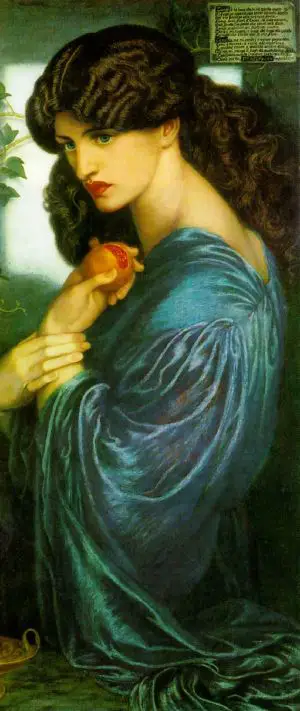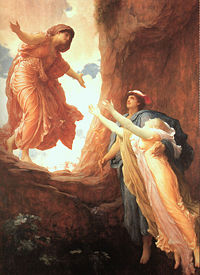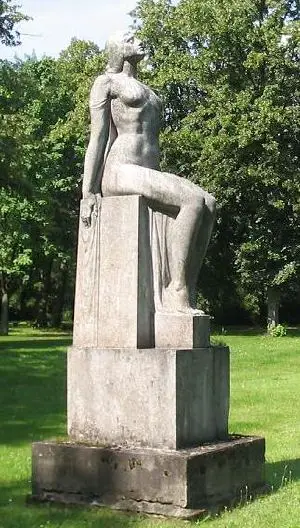Persephone

In Greek mythology, Persephone (also known as Kore or Cora ("Young maiden")) was the embodiment of the Earth's fertility and the Queen of the Underworld. She is often mentioned as a paradigm of myths that explain natural processes such as the change of seasons. Her story, however, has an ambivalent place in ancient Greek mythology: On the one hand, her innocent abduction and rape by Hades, and her mother's subsequent search for her daughter has great emotional power. In this light, Persephone symbolizes a type of life-death-rebirth deity, whose eventual return signifies new life.
On the other hand, Persephone was seen as a frightening figure among the ancient Greeks because she helped rule the dead with Hades/Pluto. Her name was not safe to speak aloud and thus she was given the euphemistic title, Kore, "The Maiden." "As wife of Pluto, she sent spectres, ruled the ghosts, and carried into effect the curses of men."[1]
In western culture, art, and literature, Persephone has been associated with many other motifs including the idea of the twinned feminine, and mythological female ambivalence akin to Eve's portrayal in the Bible. She has been an enduring figure of lore resulting in a variety of interpretations from feminist critiques of patriarchalism, to men foisting their own fears and lust on to the feminine.
In astronomy, Persephone is also the name of a Main belt asteroid with a diameter of 49.1km, discovered by Max Wolf in 1895 from Heidelberg.
Her name
"Persephone" (Greek: Ī ĪµĻĻĪµĻĻĪ½Ī·, PersephonÄ) is her name in the Ionic Greek of epic literature. The Homeric form of her name is Persephonea (Ī ĪµĻĻĪµĻĪæĪ½Ī·ĪÆĪ±, PersephonÄia). In other dialects she was known under various other names: Persephassa (Ī ĪµĻĻĪµĻĪ±ĻĻĪ±), Persephatta (Ī ĪµĻĻĪµĻĪ±ĻĻĪ±), or simply [Core] (ĪĻĻĪ·, KorÄ, "girl, maiden"[2]) (when worshiped in the context of "Demeter and Core"). Plato calls her Pherepapha (Ī¦ĪµĻĪĻĪ±ĻĪ±) in his Cratylus, "because she is wise and touches that which is in motion."
The Romans first heard of her from the Aeolian and Dorian cities of Magna Graecia, who used the dialectal variant Proserpine (Ī ĻĪæĻĪµĻĻĪ¹Ī½Ī·, ProserpinÄ). Hence, in Roman mythology she was called Proserpina, and as a revived Roman Proserpina, she became an emblematic figure of the Renaissance. At Locri, perhaps uniquely, Persephone was the protector of marriage, a role usually assumed by Hera; in the iconography of votive plaques at Locri, her abduction and marriage to Hades served as an emblem of the marital state; children at Locri were dedicated to Proserpina, and maidens about to be wed brought her their peplos to be blessed.[3]
In a text ascribed to Empedocles, (c. 490ā430 B.C.E.),[4] the name Nestis for water apparently refers to Persephone. "Now hear the fourfold roots of everything: enlivening Hera, Hades, shining Zeus. And Nestis, moistening mortal springs with tears."[5]
Of the four deities of Empedocles's elements, it is the name of Persephone alone that is tabooāNestis is a euphemistic cult titleā[6]for the Greeks knew another face of Persephone as well. She was also the terrible [Queen of the Dead], whose name was not safe to speak aloud, who was euphemistically named, simply as, Kore, "The Maiden," a vestige of her archaic role as the deity ruling the underworld.
The Abduction Myth
Originally, Persephone was the parthenogenic daughter of Demeter but in later Classical myths, she became a daughter of Demeter and Zeus. In the Olympian version, she also becomes the consort of Hades when he becomes the deity that governs the underworld. In the later Olympian pantheon of Classical Greece, Persephone is given a father: according to Hesiod's Theogony, Persephone was the daughter produced by the union of Demeter and Zeus.
Unlike every other offspring of an Olympian pairing of deities, Persephone has no stable position at Olympus. Persephone used to live far away from the other deities, a goddess within Nature herself before the days of planting seeds and nurturing plants. In the Olympian telling,[7] the gods Hermes, Ares, Apollo, and Hephaestus, had all wooed Persephone, but Demeter rejected all their gifts and hid her daughter away from the company of the Olympian deities. Thus, Persephone lived a peaceful life before she became the goddess of the underworld, which, according to Olympian mythographers, did not occur until Hades abducted her and brought her into the underworld. She was innocently picking flowers with some nymphsā Athena and Artemis, the Homeric hymn saysāor Leucippe, or Oceanidsāin a field in Enna when Hades came to abduct her, bursting through a cleft in the earth; the nymphs were changed by Demeter into the Sirens for not having interfered. Life came to a standstill as the devastated Demeter, goddess of the Earth, searched everywhere for her lost daughter. In some versions, Demeter forbids the earth to produce, in others she is so busy looking for Persephone that she neglects the earth, or her duties as the Earth which she represents, and in some versions the depth of her despair causes nothing to grow. Helios, the sun, who sees everything, eventually told Demeter what had happened.
Finally, Zeus, pressured by the cries of the hungry people and by the other deities who also heard their anguish, could not put up with the dying earth and forced Hades to return Persephone. However, before she was released to Hermes, who had been sent to retrieve her, Hades tricked her into eating pomegranate seeds, which forced her to return to the underworld for a season each year. When Demeter and her daughter were united, the Earth flourished with vegetation and color, but for four months each year, when Persephone returned to the underworld, the earth once again became a barren realm. This ancient story helped to explain the seasons. This myth also can be interpreted as an allegory of ancient Greek marriage rituals. The Classical Greeks felt that marriage was a sort of abduction of the bride by the groom from the bride's family, and this myth may have explained the origins of the marriage ritual. The more popular etiological explanation of the seasons may have been a later interpretation.
In an earlier version, Hecate rescued Persephone. On an Attic red-figured bell krater of circa 440 B.C.E. in the Metropolitan Museum of Art, Persephone is rising as if up stairs from a cleft in the earth, while Hermes stands aside; Hecate, holding two torches, looks back as she leads her to the enthroned Demeter.[8]
The Queen of the Underworld
There is an archaic role for Persephone as the dread queen of the Underworld, whose very name it was forbidden to speak. In the Odyssey, commonly dated circa 800 to 600 C.E., when Odysseus goes to the Underworld, he refers to her as the Iron Queen. Her central myth, for all its emotional familiarity, also was the tacit context of the secret initiatory mystery rites of regeneration at Eleusis, which promised immortality to their awe-struck participantsāan immortality in her world beneath the soil, feasting with the heroes who dined beneath her dread gaze.[9]
Persephone, the Iron Queen
In one version of the myth, Persephone, as Queen of Hades, only mercifully relinquished a subject once; because the music of Orpheus was so hauntingly sad, she allowed Orpheus to bring his wife Eurydice back to the land of the living, as long as she walked behind him and he never tried to look at her face until they reached the surface. Orpheus agreed, but failed, looking back at the very end to make sure his wife was following, and he lost Eurydice forever.
Persephone also figures in the story of Adonis, the Syrian consort of Aphrodite. When Adonis was born, Aphrodite took him under her wing, seducing him with the help of Helene, her friend, and was entranced by his unearthly beauty. She gave him to Persephone to watch over, but Persephone also was amazed at his beauty and refused to give him back. The argument between the two goddesses was settled, either by Calliope, or by Zeus (depending on the antiquity of the myth), with Adonis spending four months with Aphrodite, four months with Persephone and four months of the year on his own. This later myth placed a god into the position of a goddess in the cycle of the seasons.
When Hades pursued a nymph named Minthe, Persephone turned her into a mint plant.
Persephone was the object of Pirithous's affections. In a late myth, Pirithous and Theseus, his friend, pledged to marry daughters of Zeus. Theseus chose Helen and together they kidnapped her and decided to hold onto her until she was old enough to marry. Pirithous chose Persephone. They left Helen with Theseus' mother, Aethra, and traveled to the underworld, domain of Persephone and her husband, Hades. Hades pretended to offer them hospitality and set a feast; as soon as the pair sat down, snakes coiled around their feet and held them there. Edith Hamilton called it a "Chair of Forgetfulness" that they sat upon. It also should be noted that Heracles was able to save Theseus from this fate when he was in the Underworld, but Hades forced Pirithous to remain seated forever.
Persephone and her mother Demeter were often referred to as aspects of the same Earth goddess, and were called "the Demeters" or simply "the goddesses."
Persephone in modern scholarship
Some modern scholars have argued that the cult of Persephone was a continuation of Neolithic or Minoan goddess-worship. Among classicists, this thesis has been argued by Gunther Zuntz (1973) and cautiously included by Walter Burkert in his definitive Greek Religion.
More daringly, the mythologist Karl Kerenyi has identified Persephone with the nameless "mistress of the labyrinth" at Knossos from the Bronze Age Minoan civilization on Crete that flourished from 1700 B.C.E.
On the other hand, the hypothesis of an Aegean cult of the Earth Mother has come under some criticism in recent years. For more on both sides of the controversy, see Mother Goddess.
Notes
- ā 1911 Encyclopaedia Britannica: Proserpine Retrieved July 19, 2008.
- ā H.G. Liddell and R. Scott, A Greek-English Lexicon, 9th ed. (Oxford University Press, 1995, ISBN 978-0198642268).
- ā Christiane Sourvinou-Inwood, "Persephone" The Journal of Hellenic Studies 98 (1978), 101-121.
- ā Empedocles was a Greek pre-Socratic philosopher who was a citizen of Agrigentum, a Greek colony in Sicily.
- ā Peter Kingsley, in Ancient Philosophy, Mystery, and Magic: Empedocles and Pythagorean Tradition (Oxford University Press, 1995).
- ā Kingsley 1995 identifies Nestis as a cult title of Persephone.
- ā LOVES OF HERMESĀ : Greek mythology Retrieved July 19, 2008.
- ā The figures are unmistakable, as they are inscribed "Persophata, Hermes, Hekate, Demeter"; Gisela M. A. Richter, "An Athenian Vase with the Return of Persephone" The Metropolitan Museum of Art Bulletin 26.10 (October 1931), 245-248.
- ā Kerenyi, 1967.
ReferencesISBN links support NWE through referral fees
- Burkert, Walter. Greek Religion: Archaic and Classical. Translated by John Raffan. Oxford: Blackwell, 1985. ISBN 0631112413
- Farnell, Lewis Richard. The Cults of the Greek States (5 vols.). Oxford: Clarendon Press, 1907.
- Kerenyi, Karl. Dionysos: Archetypal Image of Indestructible Life. Princeton, NJ: Princeton University Press, 1975. ISBN 0691098638
- āāā. Eleusis: Archetypal Image of Mother and Daughter. New York: Schocken Books, 1967. ISBN 0805205489
- āāā. The Heroes of the Greeks. Thames & Hudson (New edition), 1997. ISBN 050027049X
- Kingsley, Peter. Ancient Philosophy, Mystery, and Magic: Empedocles and Pythagorean Tradition. Oxford University Press, 1995. ISBN 978-0198149880
- Price, Simon. Religions of the Ancient Greeks. Cambridge: Cambridge University Press, 1999. ISBN 0521388678
- Rose, H. J. A Handbook of Greek Mythology. New York: E. P. Dutton & Co., 1959. ISBN 0525470417
- Ruck, Carl A. P. and Daniel Staples. The World of Classical Myth. Durham, NC: Carolina Academic Press, 1994. ISBN 0890895759
- Zuntz, GĆ¼nther. Persephone: Three Essays on Religion and Thought in Magna Graecia. 1973.
Credits
New World Encyclopedia writers and editors rewrote and completed the Wikipedia article in accordance with New World Encyclopedia standards. This article abides by terms of the Creative Commons CC-by-sa 3.0 License (CC-by-sa), which may be used and disseminated with proper attribution. Credit is due under the terms of this license that can reference both the New World Encyclopedia contributors and the selfless volunteer contributors of the Wikimedia Foundation. To cite this article click here for a list of acceptable citing formats.The history of earlier contributions by wikipedians is accessible to researchers here:
The history of this article since it was imported to New World Encyclopedia:
Note: Some restrictions may apply to use of individual images which are separately licensed.

